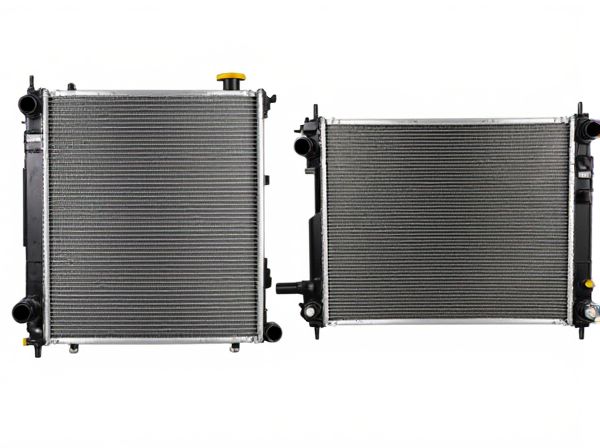
Photo illustration: Polymer Tank Radiator vs Metal Tank Radiator
Polymer tank radiators offer enhanced corrosion resistance and lightweight construction compared to traditional metal tank radiators, improving overall durability and efficiency. Metal tank radiators provide superior heat conduction and structural strength, making them ideal for high-temperature applications. Choosing the right radiator depends on your specific needs for performance, longevity, and maintenance.
Table of Comparison
| Feature | Polymer Tank Radiator | Metal Tank Radiator |
|---|---|---|
| Material | Lightweight polymer composite | Durable aluminum or brass |
| Weight | Lower weight, improves fuel efficiency | Heavier, adds vehicle weight |
| Durability | Resistant to corrosion and cracking | Strong but prone to corrosion over time |
| Cost | Generally less expensive | Higher initial cost |
| Heat Dissipation | Moderate heat resistance | Excellent thermal conductivity |
| Repairability | Harder to repair after damage | Easier to repair and weld |
| Lifespan | Typically shorter lifespan | Longer lifespan with proper maintenance |
Introduction to Radiator Tanks: Polymer vs. Metal
Radiator tanks are essential components in automotive cooling systems, responsible for housing coolant and maintaining system pressure. Polymer tanks offer advantages such as corrosion resistance, weight reduction, and design flexibility, making them popular in modern vehicles. Metal tanks, typically made from aluminum or brass, provide superior durability and heat dissipation but are heavier and prone to corrosion over time.
Material Composition and Manufacturing Processes
Polymer tank radiators are primarily composed of high-strength thermoplastics such as nylon or polypropylene reinforced with glass fibers, offering enhanced corrosion resistance and lightweight properties. Metal tank radiators typically use stamped steel or aluminum, which provides superior thermal conductivity and durability but increases overall weight. Manufacturing processes for polymer tanks involve injection molding, enabling complex shapes and reduced production costs, whereas metal tanks rely on stamping, welding, and brazing, requiring more intensive labor and equipment for assembly.
Cooling Efficiency: Polymer vs. Metal Performance
Polymer tank radiators offer enhanced cooling efficiency due to their lightweight properties, which promote faster heat dissipation compared to traditional metal tanks. Metal tank radiators, often made from aluminum or steel, excel in durability but may retain heat longer, slightly reducing overall cooling performance. Advances in polymer composites have improved thermal conductivity, making polymer tanks increasingly competitive in high-performance cooling applications.
Durability and Lifespan Comparison
Polymer tank radiators offer superior corrosion resistance compared to metal tank radiators, reducing the risk of leaks and extending overall durability. Metal tank radiators, typically made from steel or aluminum, are prone to rust and scaling, which can significantly shorten their lifespan. Polymer tanks maintain structural integrity under thermal stress, often resulting in a lifespan that exceeds 10 years, whereas metal tanks may require replacement within 5 to 7 years due to corrosion-related damage.
Resistance to Corrosion and Chemical Degradation
Polymer tank radiators offer superior resistance to corrosion and chemical degradation due to their non-metallic construction, which prevents rust formation and withstands exposure to various chemicals in coolant fluids. In contrast, metal tank radiators, especially those made from aluminum or steel, are prone to corrosion over time, particularly when exposed to oxygen and moisture, necessitating regular maintenance and the use of corrosion inhibitors. The enhanced chemical stability of polymer tanks results in longer lifespan and reduced risk of leaks or failures in automotive cooling systems.
Weight and Installation Considerations
Polymer tank radiators are significantly lighter than metal tank radiators, reducing overall vehicle weight and improving fuel efficiency. Their lightweight construction simplifies installation by minimizing the need for heavy-duty mounting hardware and easing handling during assembly. Metal tank radiators offer increased durability but require more robust mounting systems and tools, making installation more labor-intensive and time-consuming.
Cost Analysis: Initial Investment and Maintenance
Polymer tank radiators typically offer a lower initial investment due to reduced manufacturing costs and materials compared to metal tank radiators, which often require more expensive metals like steel or aluminum. Maintenance expenses for polymer tanks are generally lower as they resist corrosion and do not require regular rust treatment, unlike metal tanks that demand periodic inspections and potential repairs from rust damage. Over time, the total cost of ownership favors polymer tanks because their durability and minimal upkeep reduce both direct maintenance costs and downtime.
Environmental Impact and Recycling Potential
Polymer tank radiators offer a lower environmental impact due to their reduced weight and energy-efficient manufacturing processes compared to metal tank radiators, which typically require high-temperature smelting and significant energy consumption. Polymer materials are often more recyclable and can be reprocessed with less environmental burden, whereas metal tanks, while recyclable, involve energy-intensive separation and refining processes. Choosing polymer tanks can contribute to reduced carbon emissions and easier end-of-life management, supporting sustainable radiator production and disposal.
Common Applications and Industry Preferences
Polymer tank radiators are commonly used in automotive applications due to their lightweight, corrosion resistance, and cost-effectiveness, making them preferred in passenger vehicles and light trucks. Metal tank radiators, typically aluminum or brass, dominate heavy-duty and industrial applications where durability, higher thermal conductivity, and better heat dissipation are critical. Industry preferences lean towards polymer tanks for fuel efficiency and reduced weight, while metal tanks are favored in demanding environments requiring long-term reliability and robust performance.
Choosing the Right Radiator Tank: Key Factors to Consider
When choosing between polymer tank radiators and metal tank radiators, prioritize corrosion resistance and weight for optimal performance; polymer tanks offer superior corrosion resistance and lighter weight, enhancing fuel efficiency. Assess heat dissipation and durability, as metal tanks provide better heat conduction and withstand high temperatures, ideal for heavy-duty applications. Consider maintenance requirements and long-term reliability, with polymer tanks requiring less upkeep but metal tanks often exhibiting greater overall toughness in extreme conditions.
 caratoz.com
caratoz.com